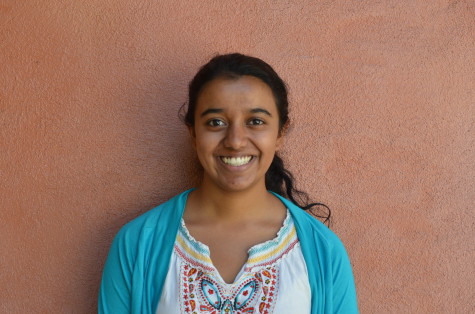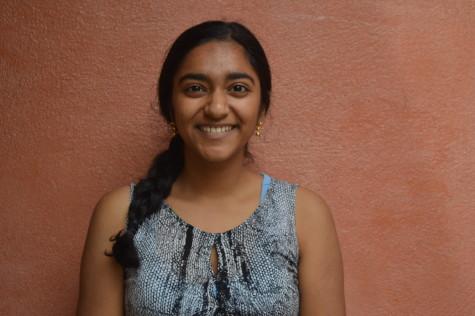AP Art History students visit Asian Art Museum of San Francisco
Senior Maya Nandakumar examines a piece of artwork from the Asian Art Museum of San Francisco. The AP Art History class visited the museum yesterday to prepare for a class project.
Nine AP Art History students visited the Asian Art Museum of San Francisco today to view contemporary and ancient works and to select two pieces of art to compare for a course project.
The museum, which originally opened in 1966, is often said to be home to the most extensive collection of Asian art in the world.
The Asian perspective was new to many students, as the AP curriculum tends to focus on western dominated art.
“It was a great idea to go there because our entire course is pretty Euro-centric and focuses a lot on the Western canon, so going to the Asian art museum reminded us of the rich, layered global nature of art,” Apoorva Rangan (12) said.
Allison Kiang (12) shared a similar sentiment and commented on her favorite exhibit.
“The trip really gave me a greater appreciation for art beyond the western tradition and allowed me to see the cross-cultural influences derived from Asian art in European works,” she said. “I really enjoyed the installations by Jung Ran Bae, a contemporary Korean American artist. His work TEAter-Totter was incredibly interesting as he uses stacked tea pots to express the uncertainty that comes with change amidst tradition.”
History and Social Science Department Chair Donna Gilbert’s students used the field trip as an opportunity to learn outside the classroom. They were assigned a project in which they are asked to compare two pieces of art. Samyukta Yagati (12) chose to write about two works that feature the same subject from different geographical viewpoints.
“The trip was helpful because it allowed us to look at art in real life and make our own analyses instead of being limited to the textbook,” she said. “I’m comparing statues of Vishnu from Cambodia and Karnataka.”
For more information about the Asian Art Museum of San Francisco, visit http://www.asianart.org.

Megy Appalaraju (12) is the Sports Editor of Harker Aquila. This is her second year in the Harker journalism program. Her favorite part about journalism...

Apoorva Rangan (12) is the Editor-in-Chief of The Winged Post and a fourth-year staff member. She has previously served as the paper’s Managing Editor...


















![“[Building nerf blasters] became this outlet of creativity for me that hasn't been matched by anything else. The process [of] making a build complete to your desire is such a painstakingly difficult process, but I've had to learn from [the skills needed from] soldering to proper painting. There's so many different options for everything, if you think about it, it exists. The best part is [that] if it doesn't exist, you can build it yourself," Ishaan Parate said.](https://harkeraquila.com/wp-content/uploads/2022/08/DSC_8149-900x604.jpg)




![“When I came into high school, I was ready to be a follower. But DECA was a game changer for me. It helped me overcome my fear of public speaking, and it's played such a major role in who I've become today. To be able to successfully lead a chapter of 150 students, an officer team and be one of the upperclassmen I once really admired is something I'm [really] proud of,” Anvitha Tummala ('21) said.](https://harkeraquila.com/wp-content/uploads/2021/07/Screen-Shot-2021-07-25-at-9.50.05-AM-900x594.png)







![“I think getting up in the morning and having a sense of purpose [is exciting]. I think without a certain amount of drive, life is kind of obsolete and mundane, and I think having that every single day is what makes each day unique and kind of makes life exciting,” Neymika Jain (12) said.](https://harkeraquila.com/wp-content/uploads/2017/06/Screen-Shot-2017-06-03-at-4.54.16-PM.png)








![“My slogan is ‘slow feet, don’t eat, and I’m hungry.’ You need to run fast to get where you are–you aren't going to get those championships if you aren't fast,” Angel Cervantes (12) said. “I want to do well in school on my tests and in track and win championships for my team. I live by that, [and] I can do that anywhere: in the classroom or on the field.”](https://harkeraquila.com/wp-content/uploads/2018/06/DSC5146-900x601.jpg)
![“[Volleyball has] taught me how to fall correctly, and another thing it taught is that you don’t have to be the best at something to be good at it. If you just hit the ball in a smart way, then it still scores points and you’re good at it. You could be a background player and still make a much bigger impact on the team than you would think,” Anya Gert (’20) said.](https://harkeraquila.com/wp-content/uploads/2020/06/AnnaGert_JinTuan_HoHPhotoEdited-600x900.jpeg)

![“I'm not nearly there yet, but [my confidence has] definitely been getting better since I was pretty shy and timid coming into Harker my freshman year. I know that there's a lot of people that are really confident in what they do, and I really admire them. Everyone's so driven and that has really pushed me to kind of try to find my own place in high school and be more confident,” Alyssa Huang (’20) said.](https://harkeraquila.com/wp-content/uploads/2020/06/AlyssaHuang_EmilyChen_HoHPhoto-900x749.jpeg)



